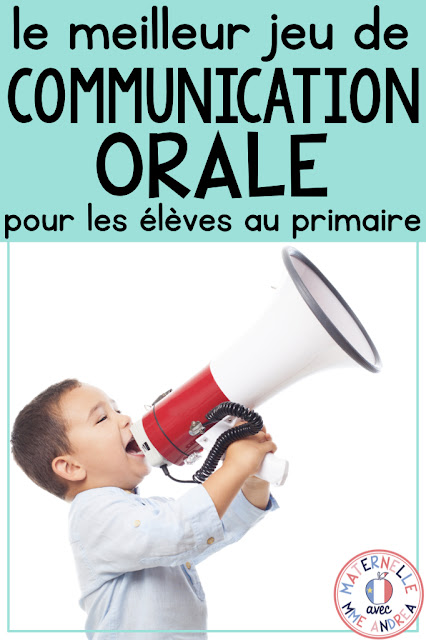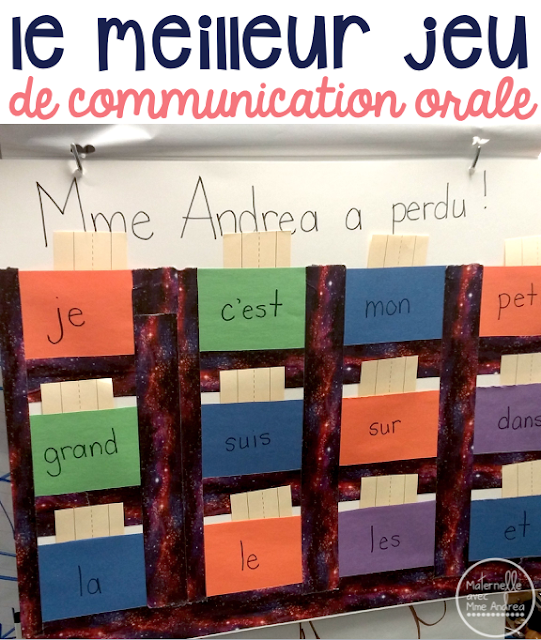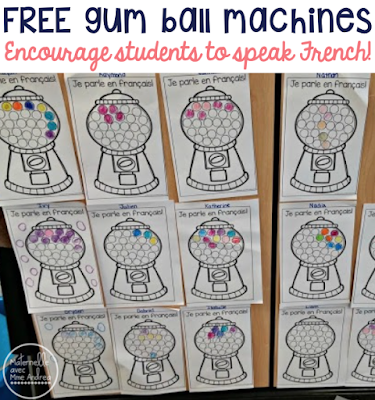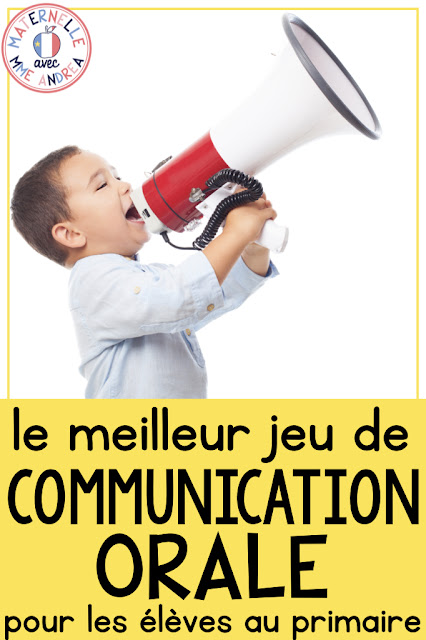Happy long weekend!
I can never quite believe it when this weekend rolls around, because it means that we are in the home stretch. The last “break” before the end of the school year! I love the extra day off, but I also panic a bit, because I am always concerned that I haven’t taught my kids quite enough to have them 100% ready for grade one. There is always more to teach!
At this point in the year, I expect all of my students to be speaking in French all the time. And, although there are always exceptions, 99% of my students can and do make the effort to speak French as much as possible throughout the day (minus perhaps when they are on the playground and I can’t hear them, ha!).
However, my big focus for communication orale at this time of the year tends to switch from “are they speaking often?” to “are they speaking CORRECTLY?”
Although I teach at a francophone school, we are in a minority community, and the reality is that our students speak using a LOT of “anglicismes” and incorrect structure. In fact, our school improvement plan for elementary is totally centred around improving our students’ correctness when they speak.
Today, I would like to share with you my FAVOURITE game for teaching and practicing correct sentence structure. In my humble opinion, it is the best oral communication game for young students. Read on to find out why I think so, and how to set it up and play!
Speaking with correct structure is important. I know that we are all about getting our second language-learners to take risks, and we don’t want to correct them all the time for fear that they will stop trying, but I think it is super reasonable to teach and practice certain structures, and then expect students to use them. I have never had a student get upset at a reminder to try to self-correct a structure that we have practiced together.
Speaking is the foundation of all literacy. If our students cannot speak correctly, they will be unable to then write correctly, and read correctly – they won’t be able to use the structure of a sentence they are reading to anticipate the next word, or self-correct, as they won’t hear the mistake in what they said. So please, to help ensure their future success, help your students learn how to speak correctly, and expect them to use those structures that you have taught and practiced in every day conversation!
But, how can we teach and practice these correct structures in a way that is fun, engaging, and allows EVERY student to practice saying the structure over and over?
Enter my favourite game…
Mme (or Monsieur) ________ a perdu!
This game is a whole-class game, students vs. teacher, and just so you are prepared…
I have never, ever won ;)
It is super easy to make, and uses materials that I’m sure you already have kicking around!
You will need:
– a piece of bristol board
– duct tape (I got some decorative duct tape from Santa, so I used that)
– some sort of paper or envelopes to use as pockets (I just used construction paper, but the other primary teacher at my school used those little envelopes you put in the back of library books, and hers looks amazing!)
– some sort of paper to use as the game cards (I used cut up sentence strips)
Here is what it will look like all set up:
I made mine with 12 pockets, but I wish I would have tried to fit 16, so that more of my students could have a turn each round. My game is not super pretty, but it works really well…and took 15 minutes to make one morning before my students arrived. You can easily pretty it up with nicer duct tape and a fancier title!
To make the pockets, I just cut rectangles of construction paper and taped the sides and bottoms using long strips of duct tape, leaving the tops open. The other teacher at my school laminated hers, and sliced open the tops of each pocket with an Exacto knife, and it worked really well!
You can put anything you want on the pockets – sight words, numbers, letters, shapes, etc. – anything that you want to bonus practice along with communication orale. I chose sight words, but throughout the year I cover them up with sticky notes and switch it up. In the beginning of the year, I put letters, and then gradually added in the sight words as we learned them.
Inside each pocket is a card. Five of the cards have a word or punctuation sign on them – “Mme,” “Andrea,” “a,” “perdu,” and “!.”
The object of the game is to have your students find those five cards. If/when they find them all, they win!
The other cards are blank.
To play, you will first need to pick a sentence structure to practice.
Here are a few ideas that I use throughout the year:
– “J’ai …. ans.”
– “Est-ce que je peux aller…”
– “Je suis allé…”
– “Nous allons…”
– “Nous sommes…”
– “chez…”
– “Je vais…”
etc.
Sometimes I combine a couple – like “Je suis allé chez…”
You can also go super simple if your students have never been exposed to French before – “C’est un(e)…”, Je vois un(e)…”, etc., and focus more on vocabulary.
Once I have told my students which structure we are practicing, and have them repeat it back a few times, we are ready to play! Sometimes, I use vocabulary cards (I just grab some vocab cards from my Phrases fantastiques sets, but you could use flash cards or drawings or whatever you want!) to have them complete the sentence, in which case, we would review those first. Other times, I will just write someone’s name or a number on a white board and then turn it around and have them use that to complete the sentence.
For example, if we were practicing “Est-ce que je peux aller…”, I would grab the vocabulary cards from Phrases fantastiques – on y va!. I would show one card and say, “Où veux-tu aller?” and my whole class answers together: “Est-ce que je peux aller (à la plage, à l’école, à la bibliothèque, etc.)?”
If we were practicing saying our age correctly, I would grab a white board. I would either pick a student to use in my question and write down their real age on the white board (my students get more excited when I include them in the questions, but it means you practice fewer numbers), or I would write a random number. I would ask, “Madison, quel âge as-tu?” and the whole class would answer “J’ai 5 ans.”
The key thing is that the WHOLE class answers, EVERY SINGLE TIME, even if I say someone else’s name – they ALL answer as that person. This way, my students are ALL practicing the correct structure over and over and over.
Then, I pick someone that I saw answering correctly to choose a pocket. I am very strict that in order to choose a pocket, the student I pick must stay seated and identify which pocket they want by reading the sight word on the pocket. Pointing at it doesn’t count, but they can ask a friend for help!
I make a huge deal pulling out the card s-l-o-w-l-y and dramatically. If the card is blank, I thank them profusely, tell them I love them, and how happy I am that I haven’t lost yet, ha! If the card has a word on it, everyone cheers, and I tape it on the board below the game. Once all five words are up on the board, they win and I lose! I will often play a Just Dance video on Youtube as their “prize”.
Sometimes I try to trick them, and tell them to pick a certain card, or not to pick a certain card. They have caught on that they should probably do the opposite of what I say ;)
So simple, but so fun, and very effective and engaging!
I love this game for a few reasons. First of all, every student is engaged and every student is saying AND hearing the correct structure over and over. And, they are hearing and speaking it in context, in a way that makes sense! Research shows that it is easier to remember words in “chunks,” in context, rather than in isolation. I see a huge difference in my students when they are now using those structures spontaneously – it becomes much more natural to use them correctly.
I also don’t have to correct my students anymore by telling them the structure each time they make a mistake and having them repeat it back. If a student says “nous va…” I just look at them and say “nous…” and they are able to correct on their own.
You may remember from this post, but I use gum balls to encourage my students to speak French. When they finish, they get to play games on the computer during one centre rotation. If I catch them using a practiced structure correctly and spontaneously, they get to colour TWO gum balls – it’s a huge deal!!!
You can grab those gum balls in my FREE French Resource Library! If you aren’t a member yet, it’s easy – just enter your name and email below and I will email you the password. Then you can access every freebie I have ever made!!






This comment has been removed by the author.
This comment has been removed by the author.
est-ce que tu utilise la meme phrase peut importe l'enfant qui choisit, si j'ai 4 enfants dans ma classe on redit la meme phrase 4 fois? estce que l'enfant peut changer la réponse a la question?